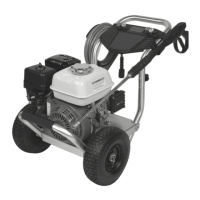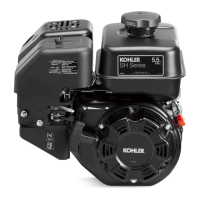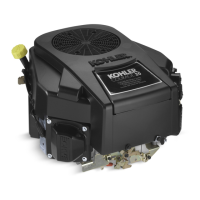18
Troubleshooting
Whentroublesoccur,besuretocheckthesimplecauseswhich,atrst,mayseemtooobvioustobeconsidered.
Forexample,astartingproblemcouldbecausedbyanemptyfueltank.Somecommoncausesofenginetroubles
are listed in the table below.
Donotaempttoserviceorreplacemajorenginecomponents,oranyitemsthatrequirespecialtimingor
adjustmentprocedures.HavethisworkdonebyaKohlerEngineServiceCenter.
Storage
Iftheenginewillbeoutofservicefortwomonthsor
more, use the following storage procedure:
1. Cleantheexteriorsurfacesoftheengine.
2. Changetheoilwhiletheengineisstillwarmfrom
operation. Refer to Change Oil.
3. Thefuelsystemmustbecompletelyemptied,
or the gasoline must be treated with a stabilizer
topreventdeterioration.Ifyouchooseto
use a stabilizer, follow the manufacturers
recommendations, and add the correct amount
for the capacity of the fuel system. Fill the fuel
tank with clean, fresh gasoline. Run the engine
for5minutestogetstabilizedfuelintothe
carburetor.
To empty the system, run the engine until the
tank and system are empty.
4. Removethesparkplug.Addonetablespoonof
engineoilintothesparkplughole.Installthe
plug,butdonotconnectthepluglead.Crankthe
engine two or three revolutions.
5. Removethesparkplug.Coverthesparkplug
hole with your thumb, and turn the engine over
untilthepistonisatthetopofitsstroke.(Pressure
againstthethumbisgreatest.)Reinstalltheplug,
but do not connect the plug lead.
6. Storetheengineinaclean,dryplace.
Transport
1. Turn the fuel valve to the OFF position.
2. Tightenthefuelcap.
3. Readandfollowthetransportguidelines
provided by equipment manufacturer.
Possible Cause
Problem
No
Fuel
Improper
Fuel
Dirt In
Fuel Line
Dirty
Debris Screen
Incorrect
Oil Level
Engine
Overloaded
Dirty Air
Cleaner
Faulty
Spark Plug
Will Not Start
Hard Starting
Stops Suddenly
Lacks Power
Operates Erratically
Knocks or Pings
Skips or Misres
Backres
Overheats
High Fuel
Consumption

